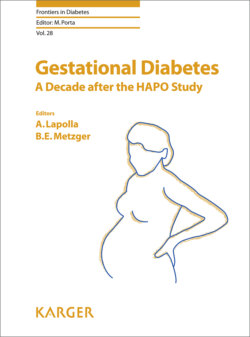Читать книгу Gestational Diabetes - Группа авторов - Страница 65
На сайте Литреса книга снята с продажи.
Clinical and Economic Consequences of Adopting the IADPSG Criteria
ОглавлениеOther than all the practical issues for implementing the IADPSG criteria, the single most important question is – is it indeed better for the women and their offspring?
Treating GDM is usually straightforward and uncomplicated, mostly by diet, with 8–20% failing to achieve glycemic control, switching to pharmacological treatment. This may be interpreted in favor for adopting low thresholds, so all “newly” diagnosed will be treated successfully by diet. However, this does not take into account that overdiagnosis and overtreatment may break the primary directive of “primum non nocre.” Iatrogenic outcomes of GDM management may include frequency of visits and monitoring, labor induction, cesarean delivery, patient’s discomfort of self-monitoring blood glucose, frequent prenatal care appointments, and last but not least the psychological burden on those diagnosed.
To answer this, randomized trials are needed. The largest and best quality data available as a comparison of the traditional 2-step approach versus the 1-step IADPSG criteria stem from a recent Cochrane meta-analysis, which concluded that no specific strategy is optimal over others [70]. This meta-analysis included only a single study with 726 women, comparing the single-step 75 g approach to the 50 and 100 g 2-step approach in order to diagnose GDM at the 1st trimester and not during later gestational weeks – as such it does not provide an answer to the question at hand. The results of the RCT demonstrate that women who received the 2-step approach had a lower risk of being diagnosed with GDM at 11–14 gestational weeks (RR 0.51, 95% CI 0.28–0.95), with no other maternal or perinatal outcomes reported [71].
In another RCT, not included in the abovementioned meta-analysis [72], 386 women were randomized to 75 g 1-step strategy and 400 women to the 2-step strategy. The prevalence of GDM was more than doubled from 6 to 14.5% in the 2-step subgroup, while those who were defined as normal glucose tolerance by IADPSG had lower rates of polyhydramnios and preeclampsia.
Other than this RCT, paucity of other retrospective analysis provides insights as to the benefits, shortcomings, and costs of adopting the IADPSG criteria. Available studies suggest that women who are GDM positive according to IADPSG criteria versus those who are GDM according to WHO criteria are at a significant risk for LGA, gestational hypertension, and preeclampsia [41]. Women with GDM according to IADPSG versus those with GDM according to CDA criteria are independently associated with a higher rate of adverse perinatal outcomes, specifically gestational hypertension and preeclampsia [47]. Duran et al. [46] prospectively followed 1,750 pregnant women using the Carpenter and Coustan criteria versus 1,526 pregnant women using the IADPSG criteria, with similar treatment and follow-up. With a 3.5-fold increase in GDM prevalence, the neonatal outcomes were improved for the IADPSG subgroup, including –14.6% decrease in gestational hypertension, –10.9% prematurity, –23.9% cesarean delivery, –6.5% small for gestational age, –20% LGA, –9% for 1-min Apgar below 7, and –24.4% for NICU admission. Hung et al. [69] retrospectively compared women before and after IADPSG implementation demonstrating less macrosomia (adjusted OR 0.63, 95% CI 0.43–0.90) and fewer LGA babies (adjusted OR 0.74, 95% CI 0.61–0.89). In contrast to these reports, others have not shown such a benefit for IADPSG criteria [42–45].
Compiling all these studies together is difficult and no clear conclusion can be made as to the impact of IADPSG criteria on maternal and neonatal outcomes. In a secondary analysis of the North American untreated HAPO cohorts, Waters et al. [73] assess adverse outcomes for women who were GDMs, either by Carpenter and Coustan criteria or by the IADPSG criteria versus no GDM. Those diagnosed with GDM based on IADPSG criteria had higher birth weight, cord C-peptide, newborn fat, cesarean delivery, and preeclampsia. This may provide the most important conclusion that the current evidence needs to be strengthened with further research to assess the effect of treatment to improve outcomes in such women.
